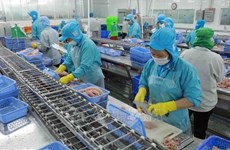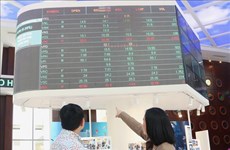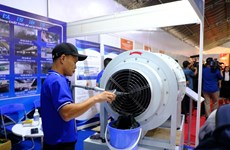Trade deficit drops, development continues
The trade deficit continued its down-turn, falling to 8.9 billion USD in
the first 11 months of 2011, a year-on-year decrease of 1.7 billion
USD, the General Statistics Office (GSO) said.
The GSO said growth in exports had been higher than imports in current months.
In the first 11 months of this year, export turnover was 22.5 billion USD, up 34.7 percent over the same period last year. Meanwhile, imports in the same period rose 26.4 percent, worth 96.07 billion USD.
The GSO said growth in exports had been higher than imports in current months.
In the first 11 months of this year, export turnover was 22.5 billion USD, up 34.7 percent over the same period last year. Meanwhile, imports in the same period rose 26.4 percent, worth 96.07 billion USD.
The trade deficit continued its down-turn, falling to 8.9 billion USD in
the first 11 months of 2011, a year-on-year decrease of 1.7 billion
USD, the General Statistics Office (GSO) said.
The GSO said growth in exports had been higher than imports in current months.
In the first 11 months of this year, export turnover was 22.5 billion USD, up 34.7 percent over the same period last year. Meanwhile, imports in the same period rose 26.4 percent, worth 96.07 billion USD.
"The price of many Vietnamese exports has increased in the current time so that the export turnover has been pushed up," said head of the office's Trade Department Le Thi Minh Thuy.
"The price of agriculture products increased by up to 66 percent while the price of crude oil increased by 43.6 percent," Thuy added.
On the contrary, Thuy noted, the prices of some imported raw materials such as fuel, cotton, rubber and steel had dropped over two months.
"Furthermore, the demand to import raw materials to serve domestic production has remained steady as many companies cut down production due to challenges caused by financial difficulties, high inflation, banking interest rates as well as high foreign exchange rates," she said.
During this time, many exports saw significant development. Coffee reached the highest growth in value (52.8 percent) followed by cashews (32.9 percent), garments and textiles (28 percent) and footwear (25.8 percent).
Some imports experiencing increased value included fertiliser (53.9 percent) and rubber (52 percent).
Thuy predicted that import value in the last month of this year would increase to serve production in order to meet coming New Year festival demands.
The industrial sectors of steel, electronics and autos, often considered pillars of the economy, are currently the main cause of the country's high trade deficit, industry insiders have said.
The situation is quite different from that in other regional countries where the three industries are often the major export earners. In Malaysia , for example, the country earns up to 60 billion USD per year from exports of electronic products. According to the Ministry of Industry and Trade, the three industries made up a trade deficit of nearly 10 billion USD out of the country's total deficit of nearly 13 billion USD last year.
The ministry reported that the electronics industry last year exported goods worth a total of 3.15 billion USD, but had to spend 5.14 billion USD to import completed products and parts.
The same situation was seen with the auto industry that saw an import value of 2.9 billion USD of cars and components last year against an export value of 1.5 billion USD.
The steel industry was the main culprit last year, spending 7 billion USD on imports of steel products and ingots while earning only 1 billion USD from exports.
This year, the steel industry trade deficit has been estimated at 4 billion USD, the electronics industry at nearly 3 billion USD and the auto industry at 1 billion USD.
Experts attributed the shortage to the flood of cheap Chinese products into the domestic market and a tax reduction in accordance with the country's commitment to the ASEAN Free Trade Area.
However, the restriction of supporting industries was the main cause of the high trade deficit as the three industries had to import nearly all materials and components for production.
Chairman of the Vietnam Steel Association Pham Chi Cuong said that the country's steel production was still in its fledgling stages and had to mainly depend on imported steel ingots.
The industry has to import roughly 45 percent of steel ingots and 80 percent of scrap for domestic steel production.
Cuong said the steel industry could currently only produce construction steel, not high-quality products such as heat-resistant flat steel and alloy steel, so almost all of that had to be imported.
The electronics industry also has to import 90 per cent of components while the auto industry imports 80 percent of parts.
Experts said they had concerns that it would be difficult to reduce the trade deficit caused by the three industries' imports in the future because supporting industries would not be able to catch up with domestic demand. /.
The GSO said growth in exports had been higher than imports in current months.
In the first 11 months of this year, export turnover was 22.5 billion USD, up 34.7 percent over the same period last year. Meanwhile, imports in the same period rose 26.4 percent, worth 96.07 billion USD.
"The price of many Vietnamese exports has increased in the current time so that the export turnover has been pushed up," said head of the office's Trade Department Le Thi Minh Thuy.
"The price of agriculture products increased by up to 66 percent while the price of crude oil increased by 43.6 percent," Thuy added.
On the contrary, Thuy noted, the prices of some imported raw materials such as fuel, cotton, rubber and steel had dropped over two months.
"Furthermore, the demand to import raw materials to serve domestic production has remained steady as many companies cut down production due to challenges caused by financial difficulties, high inflation, banking interest rates as well as high foreign exchange rates," she said.
During this time, many exports saw significant development. Coffee reached the highest growth in value (52.8 percent) followed by cashews (32.9 percent), garments and textiles (28 percent) and footwear (25.8 percent).
Some imports experiencing increased value included fertiliser (53.9 percent) and rubber (52 percent).
Thuy predicted that import value in the last month of this year would increase to serve production in order to meet coming New Year festival demands.
The industrial sectors of steel, electronics and autos, often considered pillars of the economy, are currently the main cause of the country's high trade deficit, industry insiders have said.
The situation is quite different from that in other regional countries where the three industries are often the major export earners. In Malaysia , for example, the country earns up to 60 billion USD per year from exports of electronic products. According to the Ministry of Industry and Trade, the three industries made up a trade deficit of nearly 10 billion USD out of the country's total deficit of nearly 13 billion USD last year.
The ministry reported that the electronics industry last year exported goods worth a total of 3.15 billion USD, but had to spend 5.14 billion USD to import completed products and parts.
The same situation was seen with the auto industry that saw an import value of 2.9 billion USD of cars and components last year against an export value of 1.5 billion USD.
The steel industry was the main culprit last year, spending 7 billion USD on imports of steel products and ingots while earning only 1 billion USD from exports.
This year, the steel industry trade deficit has been estimated at 4 billion USD, the electronics industry at nearly 3 billion USD and the auto industry at 1 billion USD.
Experts attributed the shortage to the flood of cheap Chinese products into the domestic market and a tax reduction in accordance with the country's commitment to the ASEAN Free Trade Area.
However, the restriction of supporting industries was the main cause of the high trade deficit as the three industries had to import nearly all materials and components for production.
Chairman of the Vietnam Steel Association Pham Chi Cuong said that the country's steel production was still in its fledgling stages and had to mainly depend on imported steel ingots.
The industry has to import roughly 45 percent of steel ingots and 80 percent of scrap for domestic steel production.
Cuong said the steel industry could currently only produce construction steel, not high-quality products such as heat-resistant flat steel and alloy steel, so almost all of that had to be imported.
The electronics industry also has to import 90 per cent of components while the auto industry imports 80 percent of parts.
Experts said they had concerns that it would be difficult to reduce the trade deficit caused by the three industries' imports in the future because supporting industries would not be able to catch up with domestic demand. /.













